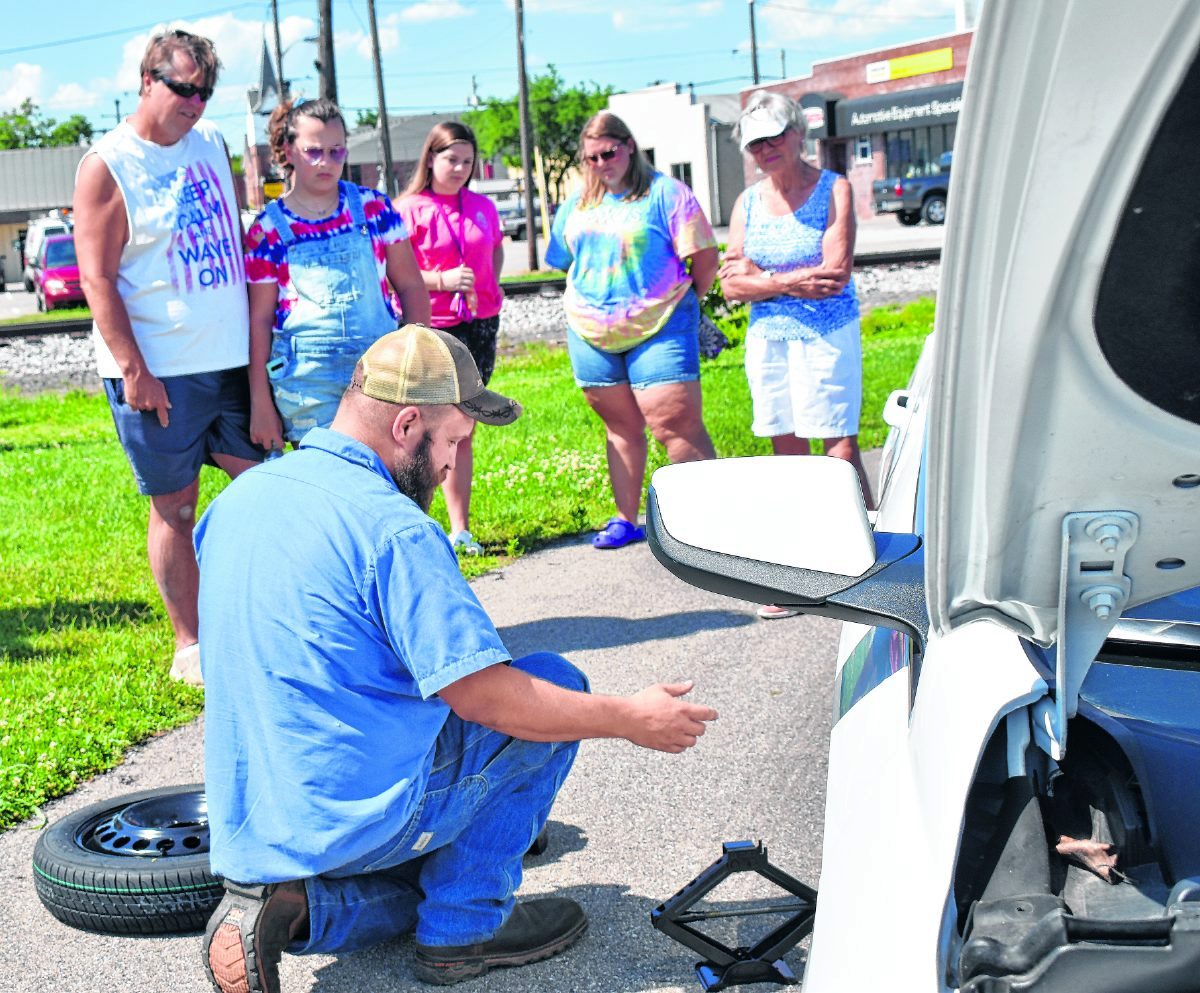
Next summer, Macy Casner will get behind the wheel and learn to drive when she takes a driver’s education course.
But this summer, the 14-year-old is getting a head start on educating herself on what to do in the event she’s in a vehicle that breaks down.
Whether it’s a car that needs coolant, oil or a jump, as a senior Girl Scout, Casner wants to be prepared for any and all situations, including a flat tire.
[sc:text-divider text-divider-title=”Story continues below gallery” ]
Click here to purchase photos from this galleryLast Thursday, Casner and her father, Monty Casner, attended a public education course on roadside emergencies staged at Crossroads Community Park in downtown Seymour.
She and six other people were schooled on how to change a tire, fix a flat and other useful skills to have when driving or riding in a car.
“I hadn’t really thought of how dangerous it could be,” Macy said of having to change a tire.
For Casner, there was more on the line than just the personal knowledge of how to change a tire. She also was in pursuit of obtaining a car care badge for Girl Scouts.
Led by Seymour Police Department Public Information Officer Jeremy Helmsing, the clinic is the first in what the department hopes is regular sessions aimed at providing valuable information to the public and giving citizens tools and resources to help keep themselves safe.
To provide a visual demonstration for the class, Josh Spivey, head mechanic for the Seymour Department of Public Works, removed a tire and put on a spare, explaining the steps as he went.
Seymour Mayor Matt Nicholson provided some assistance in getting the lug nuts off of the tire.
Spivey also showed how to use a tire inflator and how changing a tire on a truck is different than a car.
The vehicles and tools were provided by Bob Poynter GM in Seymour.
Monty Casner said the course was proof you can teach an old dog new tricks.
“The changes with technology going from spare tires to plug-in units containing a compressor and fix-a-flat was amazing,” he said. “I knew that roadside emergencies are dangerous but sometimes we need a refresher.”
Helmsing said the department plans to offer more flat tire clinics in the future.
“We want to be able to give people basic knowledge of what to do,” he said. “We see a lot of people with flat tires, a dead battery that needs jumped, but they don’t know what to do or if they should call the police.”
If your vehicle is blocking traffic, you should always call 911 for assistance, he said.
“By blocking traffic, you could cause a crash,” he said.
The two factors to take into consideration are speed of other vehicles going by and the area you’re in when determining if it’s safe to change a tire on your own.
In a residential neighborhood, where there is minimal traffic at a slower speed, it would be much safer than on the side of the interstate or a busy highway, he said.
“And always be cautious with left side tire repairs,” he said. “Don’t be afraid to call us.”
Helmsing advised the best thing to do is familiarize yourself with where things are located in your vehicle, including the spare tire or inflator and other tools you will need, including a jack, a lug wrench and the vehicle owner’s manual.
After putting on a spare tire, Helmsing said it’s only good for a certain amount of miles, in most cases about 50, so it must be replaced with a new tire right away.
Other topics being explored for future classes include basic firearm safety, first aid, home security, personal safety and self-defense and cybersecurity.
Sam Castetter, 16, and his father, Bill, both said the information shared at the clinic was useful.
“It’s one of those things every driver should know how to do,” Sam said of changing a tire. “I was glad I got to go.”
Bill said he appreciated the police department taking the time to organize the class.
“I hope more people attend the next time,” he said.
But the flat tire clinic wasn’t just for teenagers. Also attending and asking the most questions was Barb Bentley. She read about the clinic in the newspaper and decided it would be good to go.
Although she had some knowledge of vehicles beforehand, she still found the clinic interesting and helpful.
She said it’s up to her to take care of herself and to be able to do things like change a tire.
“I do it all on my own,” she said. “So doing things like this is a good way to learn.”
